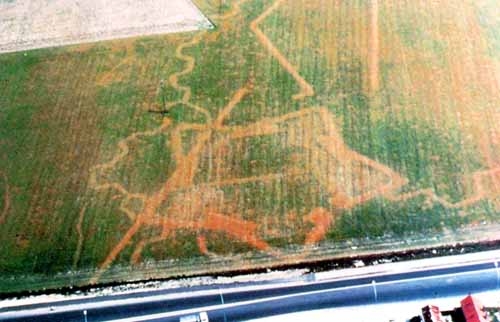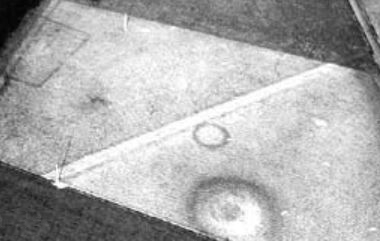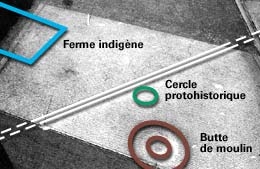- Home
- Clues on the ground
- Pitfalls and confusions
- Identifying ancient remains
A small fort, probably from the late Roman Empire, reused in the Middle Ages. It is located next to a Roman road, which has become a major highway. Le Quesnel (Somme).
When it comes to more ancient periods of time, it is a delicate operation to identify and accurately date structures located from the air, without recorse to test pits or archaeological excavation, the ultima ratio of archaeologists.
Nevertheless, lines with very characteristic geometric forms do exist, as well as ancient villas with their typical floor plans. For example, rural dwellings in northern Gaul, with their proportions and their lengthwise layout (generally flanked by a gallery façade) are easily identifiable from the air. In the same way, the layout of Roman retrenchments is also characteristic.
As always, caution is called for — some structures, such as the titulum, which are thought to be typically Roman, were brought back into use under Henri IV. Naturally, one has to be careful to avoid illusory keys to interpretation, even when taking into account fairly characteristics dimensions.
Not every small square enclosure is necessarily from the Gallic era, even if this is generally the case. In the same way, moated circles are not always from the Bronze Age, because they were still in existence in the Merovingian era and afterwards. They also had difference uses: surrounding certain isolated trees, as roadside crosses or windmill mounts, and even for protecting batteries of anti-aircraft guns during the Second World War. Small differences can help tell them apart.
A small, star-shaped fort from Henry IV's siege of Amiens in 1597, and zigzagging trenches from 1918. North of Amiens (Somme).
A windmill mount surrounded by an irregularly-shaped drainage ditch and a very regular protohistoric circle. The straight whitish line is an old country access road. North of Abbeville (Somme).
A windmill mount surrounded by an irregularly-shaped drainage ditch and a very regular protohistoric circle. The straight whitish line is an old country access road. North of Abbeville (Somme).
Be careful of formal similarities, which are often false. As Montaigne remarked, with his usual lucidity, "Resemblance does not so much make one, as difference makes another." It is the little "differences" to which we need to pay particular (but not exclusive) attention.




